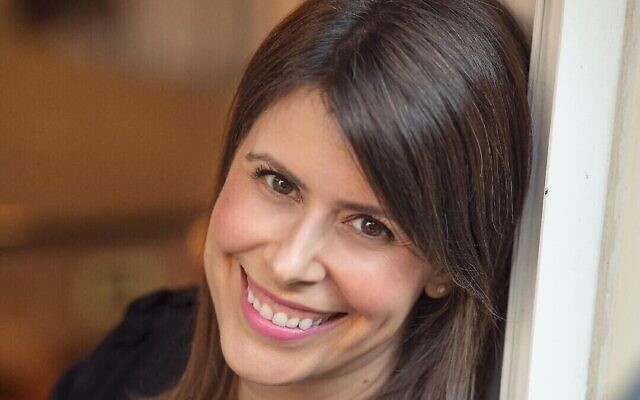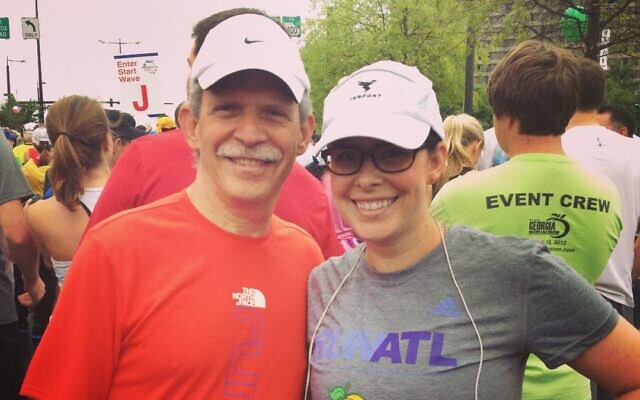Local Author Highlights History of Women’s Exercise
Jewish women were among pioneers of female physical fitness evolution.

Not every first-time author has her book reviewed in the New York Times. But Atlanta native Danielle Friedman said she is “very, very grateful” for the review that came out Dec. 21, just weeks ahead of the release of her book, “Let’s Get Physical: How Women Discovered Exercise and Reshaped the World,” on Jan. 4.
“I believe that this is an important story that needs to be told and I want as many people as possible to read it,” she said, explaining her reaction to the review. She also told the AJT that the Times purchased first-time rights to excerpt her book.
According to a review in Publishers Weekly, “Friedman takes a jaunt through the history of women’s fitness in her astute and entertaining debut … This zippy history is bursting with energy.”
The 40-year-old journalist, who originally launched her writing career as a nonfiction book editor at Penguin imprints Hudson Street Press and Plume before working as a senior editor at NBC News Digital and The Daily Beast, grew up in East Cobb. She had her baby-naming and bat mitzvah at Congregation Etz Chaim.
Friedman’s book grew out of a 2018 feature story she wrote about the “secret sexual history” of working out for New York magazine’s The Cut, which ended up going viral. In researching the article, which pursued the origins of the barre workout, she was amazed to discover its remarkable origins and role in feminist history.

Friedman was also surprised at how many of the pioneers of women’s physical fitness were Jewish. “It kept coming up again and again,” she said. She shared the story of Lotte Berk, who created the barre routine in 1959 to help women improve their sex lives and strengthen their bodies. “Her story is interesting. She was a German dancer who had to flee the Nazis in the 1930s and went to London,” said Friedman.
Then there’s Burr Leonard, who was inspired by barre to create the Bar Method; Hinda Miller, who was one of the inventors of the sports bra; Lisa Lyon, a bodybuilding pioneer; and California-based aerobics trailblazer Gilda Marx, who invented the contemporary leotard. Friedman also mentions Lucille Roberts, who started women-only gyms in New York. As Friedman relates, Roberts was born in Soviet Tajikistan and later immigrated to the United States with her family because of anti-Semitism.
It wasn’t just women who helped the fledgling female exercise movement, though. Friedman notes that Jewish hairstylist Vidal Sassoon created haircuts that “made it easier for women to exercise. They facilitated movement,” she said.
Friedman said she always knew she wanted to be a writer. English classes at Walton High School were her favorite. When she decided to write this book, she took it very seriously. “I knew as a former book editor, nailing the proposal was important,” she said. “Besides, I needed a road map. I had some theories, but I wanted to keep an open mind. I went into the project with big questions. It was fun and fascinating to get closer to answers the more research I did.”
Friedman’s biggest surprise was finding out just “how relatively recently, vigorous, strenuous exercise became acceptable to women.” Indeed, in the first half of the 20th century, women were warned that their uteruses would literally fall out if they exercised. “Women who came of age post Title IX feel like women always had access” to exercise, she said, referring to the 1972 amendment to the Higher Education Act that prohibited sex discrimination — including pregnancy, sexual orientation and gender identity — in any educational program receiving federal financial assistance.
“My takeaway is that women’s fitness has progressed a lot,” Friedman said. In the introduction to her enlightening and entertaining book, she wrote that she learned that “because of systemic inequality and discrimination, exercise is not a right but a privilege in this country.… Just as the rich often get richer, the fit often get fitter, while the poor get sicker.”
She also noted that “this book tells the story of how America transformed from a nation where women saw vigorous exercise as ‘unfeminine’ to the world we live in today, where so many consider physical activity as a way of life.”
“I really loved every aspect of working on this project,” Friedman said, even doing most of the writing during quarantine in New York City, where she now lives. “This topic was so much fun to research. And almost everyone was excited to talk to me.” Her only frustration was not being able to get an interview with actress Jane Fonda, who created exercise videos for women to use at home. However, Friedman quoted extensively from Fonda’s writing and spoke with many in Fonda’s circle.
Friedman said she’d definitely like to write another book on women’s history. “Some under-recognized chapter of women, probably relating to health and body.”
- health & Wellness
- Local
- Jan Jaben-Eilon
- Danielle Friedman
- Let’s Get Physical: How Women Discovered Exercise and Reshaped the World
- east cobb
- New York City
- Dr. Richard Friedman
- Peachtree Road Race
- Penguin imprints Hudson Street Press
- Plume
- NBC News Digital
- The Daily Beast
- Baby Naming
- Bat Mitzvah
- congregation etz chaim
- women’s physical fitness
- jewish
- Lotte Berk
- barre routine
- nazis
- Burr Leonard
- barre
- Bar Method
- Hinda Miller
- sports bra
- Lisa Lyon
- bodybuilding pioneer
- Gilda Marx
- leotard
- Lucille Roberts
- women-only gyms
- Anti-Semitism
- Vidal Sassoon
- Walton High School
- Title IX
- Higher Education Act
- sex discrimination
- pregnancy
- sexual orientation
- gender identity
- Educational Program
- federal financial assistance
- exercise
- Physical activity
- quarantine
- Jane Fonda



comments